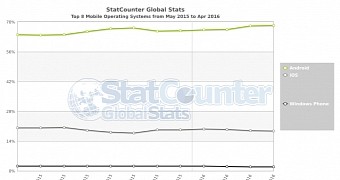They say Apple has lost its cool factor and this is one of the reasons iPhone sales declined for the first time since launch last quarter. It goes without saying that this dropping iPhone performance should reflect in Apple’s market share numbers and according to StatCounter, it kind of does.
The chart you see here concerns mobile market share in the last 12 months of three different operating systems, namely Android, iOS, and Windows Phone.
While the performance of Windows Phone has remained pretty much unchanged, not the same thing can be said about Android and iOS, which both had ups and downs in the last year. What’s more, when iOS lost users Android improved and vice versa, so it’s very clear that some of those who jumped ship from one of the platforms migrated to the other.
Android scores major increase
Specifically, iOS had a share of 20.22 percent in May 2015 and grew to 20.41 percent in July. It then started a decline to eventually drop to 17.7 percent in October 2015 before recovering a little bit the next month to 19.3 percent. Performance since November has remained almost unchanged, so iOS is now powering 18.8 percent of the phones worldwide.
In the case of Android, both the ups and downs experienced by the platform were more significant, but the difference between the market share it had 12 months ago and the one it holds today is bigger.
Android was powering 64 percent of the phones in the world in May 2015, achieving its best score – 67.15 percent – in October, the same month when iOS recorded the biggest drop. And while Android lost some market share percentage points in the next month, it eventually returned to growth.
2016 seems to be a very good year for Android so far, with the platform reaching 68.28 percent in April and all signs point to continued growth in the next months.
iPhone SE just can’t save iOS
As said, Apple’s biggest drop was experienced in October, which was the first full month on the market for the new iPhone 6s and 6s Plus. The two new refreshed models, however, are believed to be the main causes for Apple’s decline, as they sold in relatively low numbers as compared to their predecessors.
To compensate for the rather disappointing performance of the 6s lineup, Apple introduced the SE earlier this year, hoping that users of older models would finally upgrade to a phone featuring the latest hardware and software available on an Apple device.
But despite Apple’s optimistic forecasts, analysts still estimate that the iPhone SE would sell somewhere around 10 million units this year and this clearly isn’t enough to stop this slow but certain decline. The WWDC conference in June plays a key role for Apple’s short-term performance, ahead of the big launch of the iPhone 7 in September.

 14 DAY TRIAL //
14 DAY TRIAL //